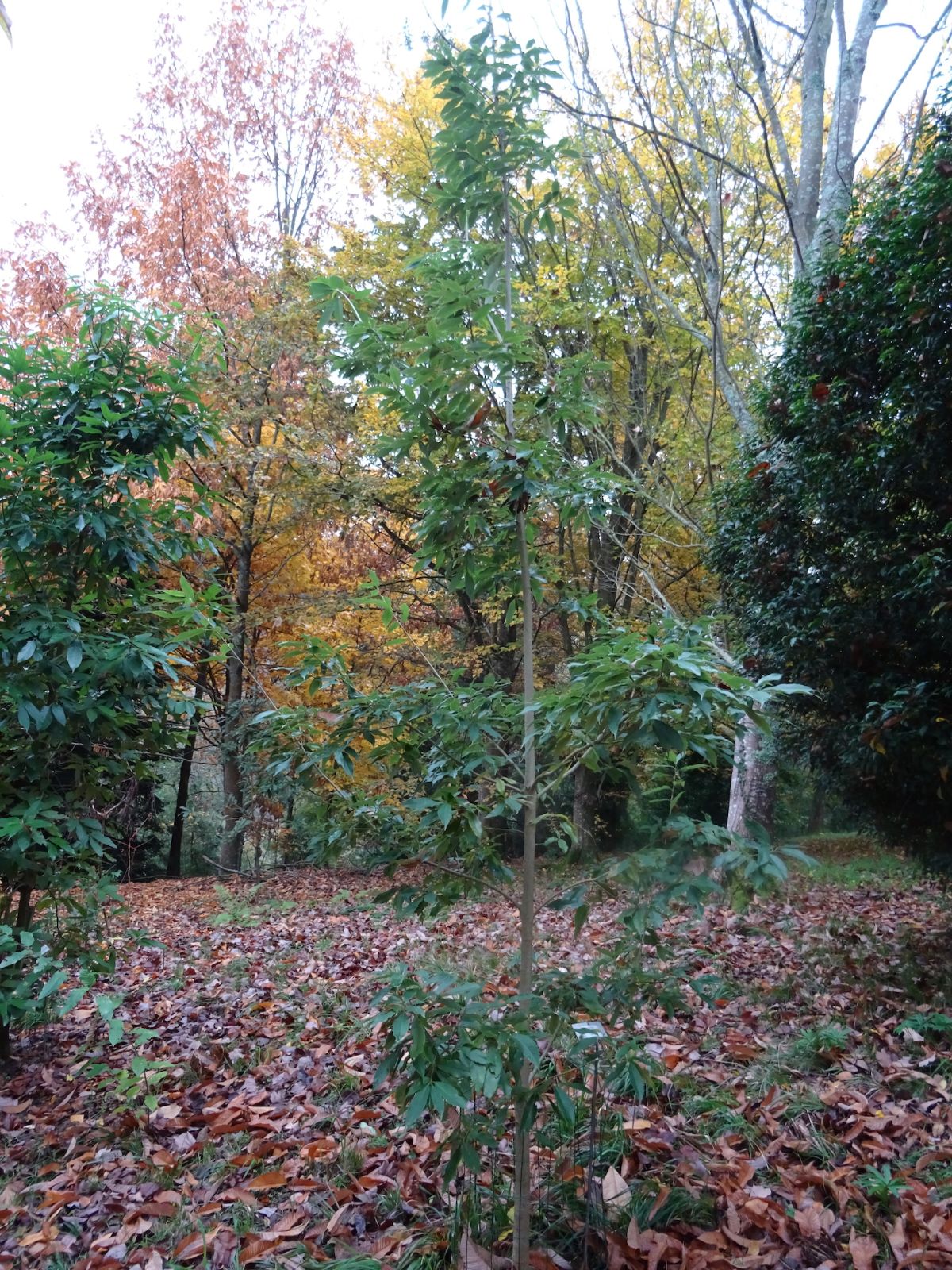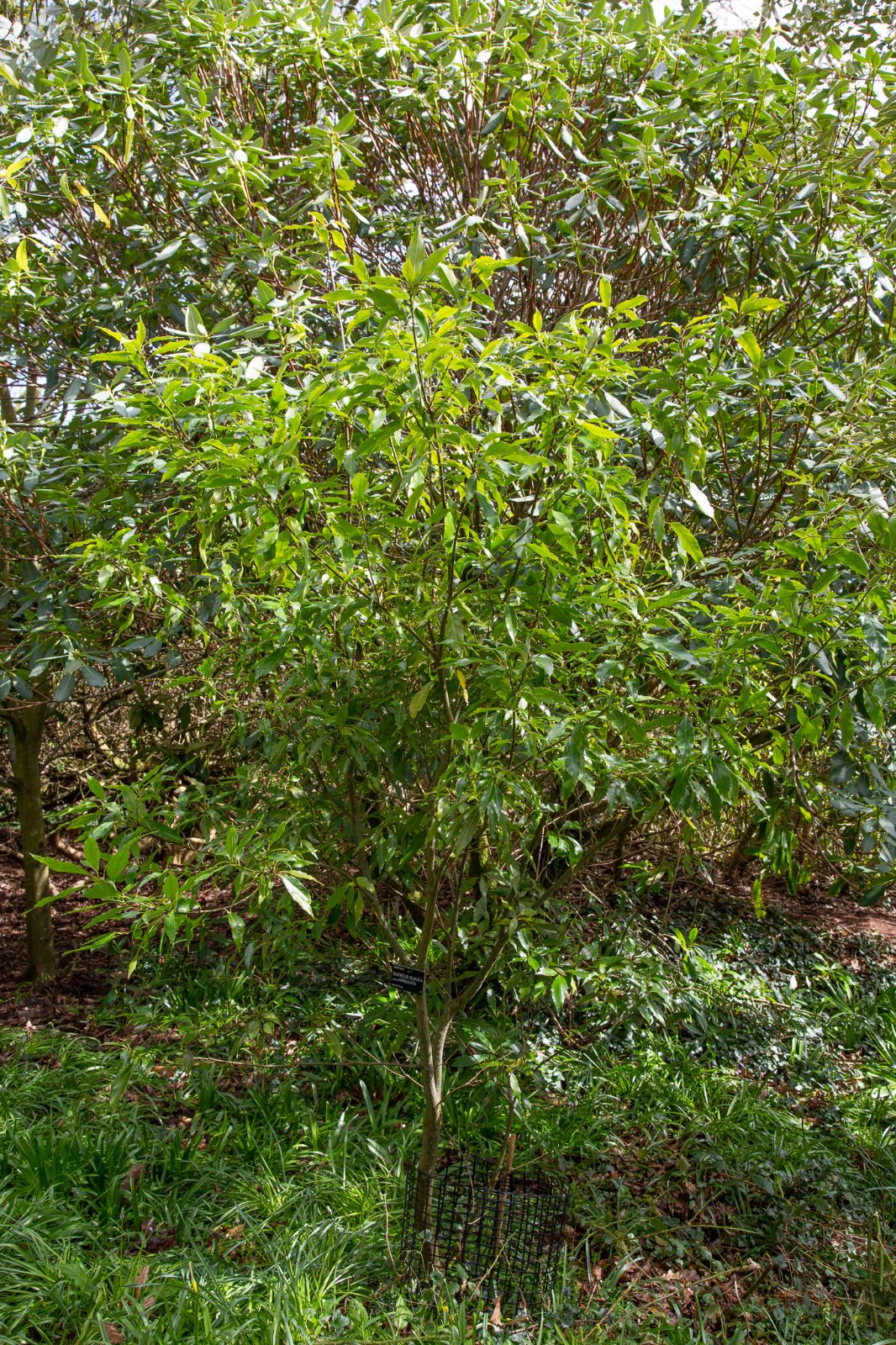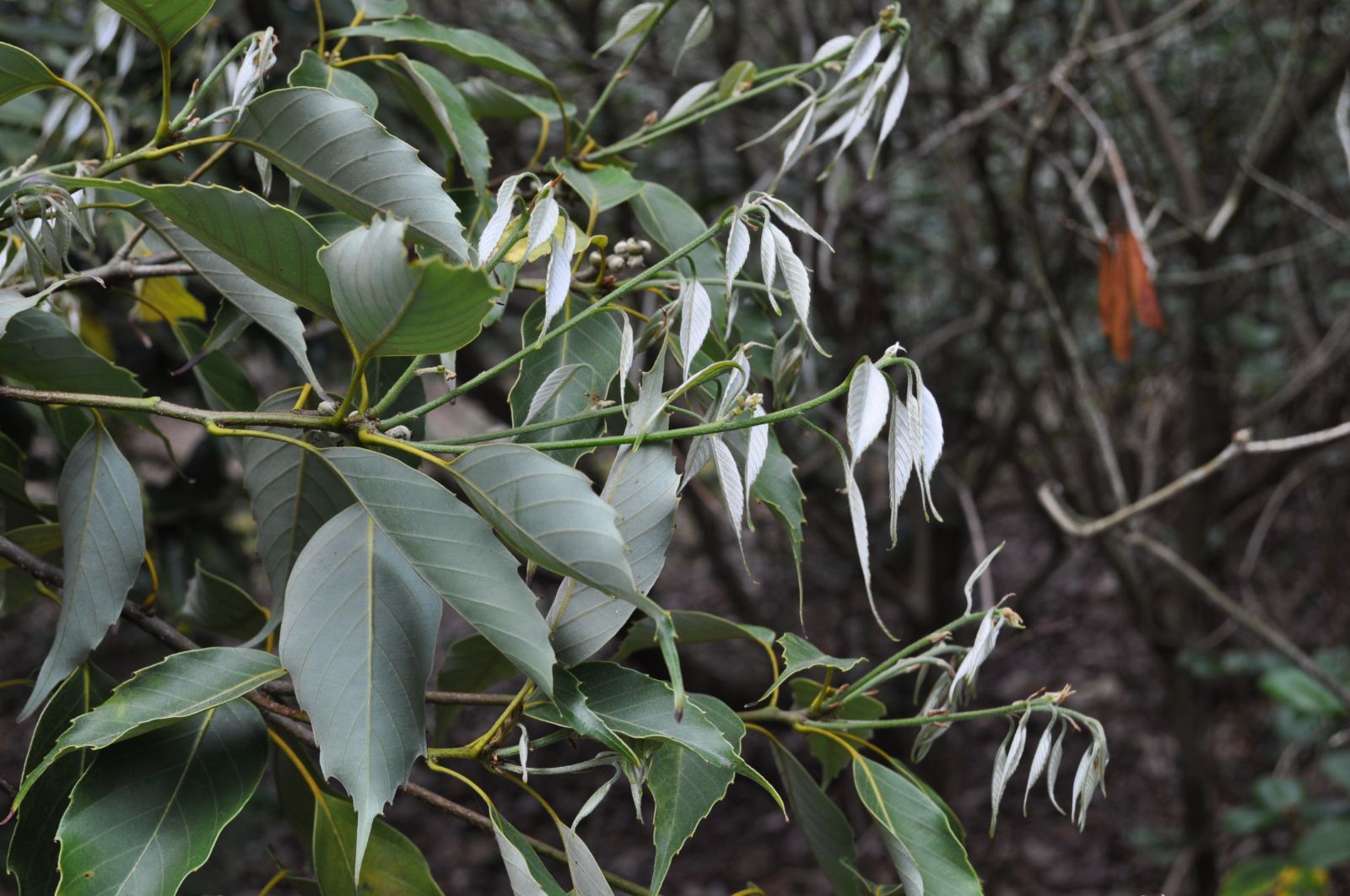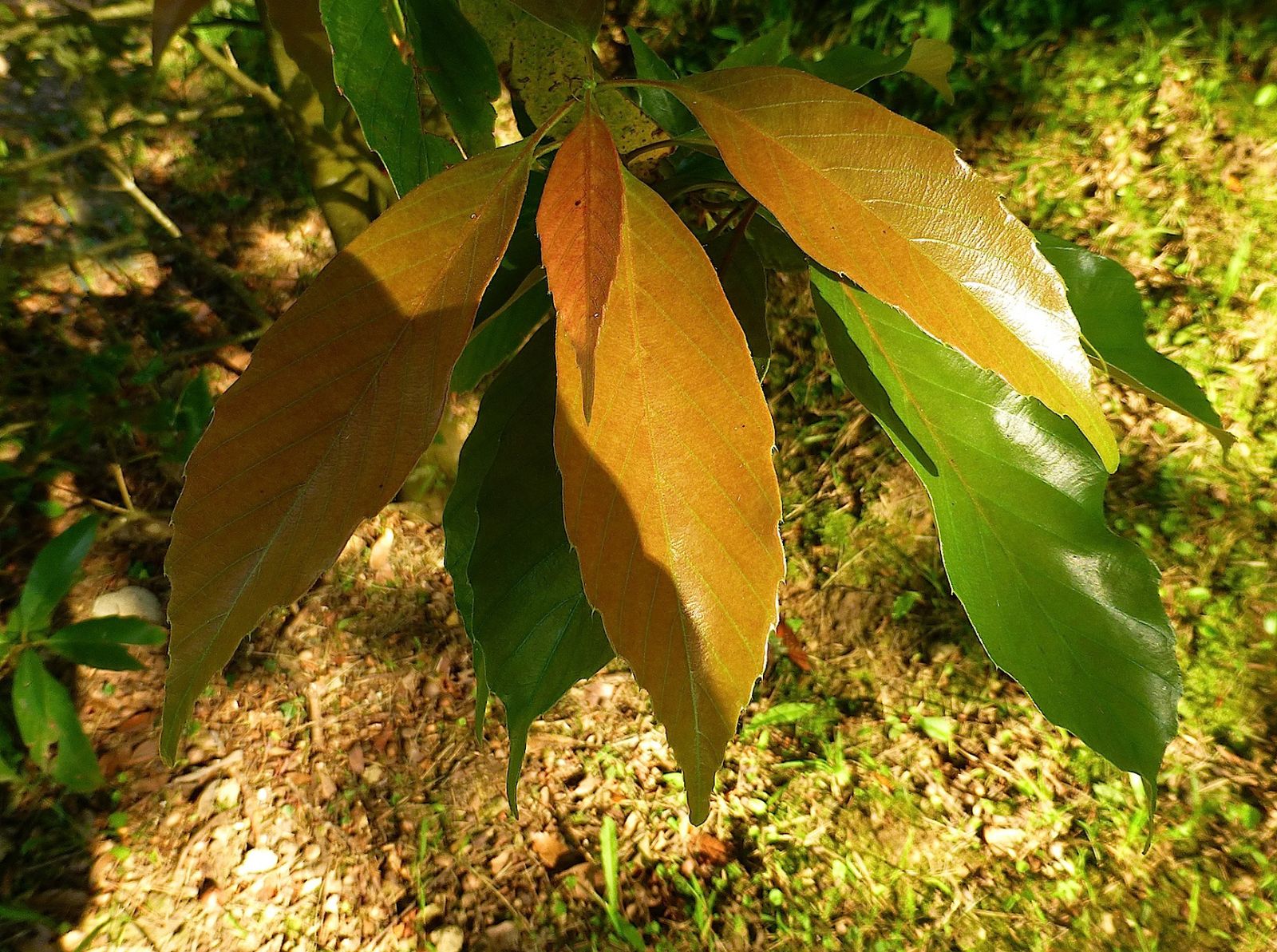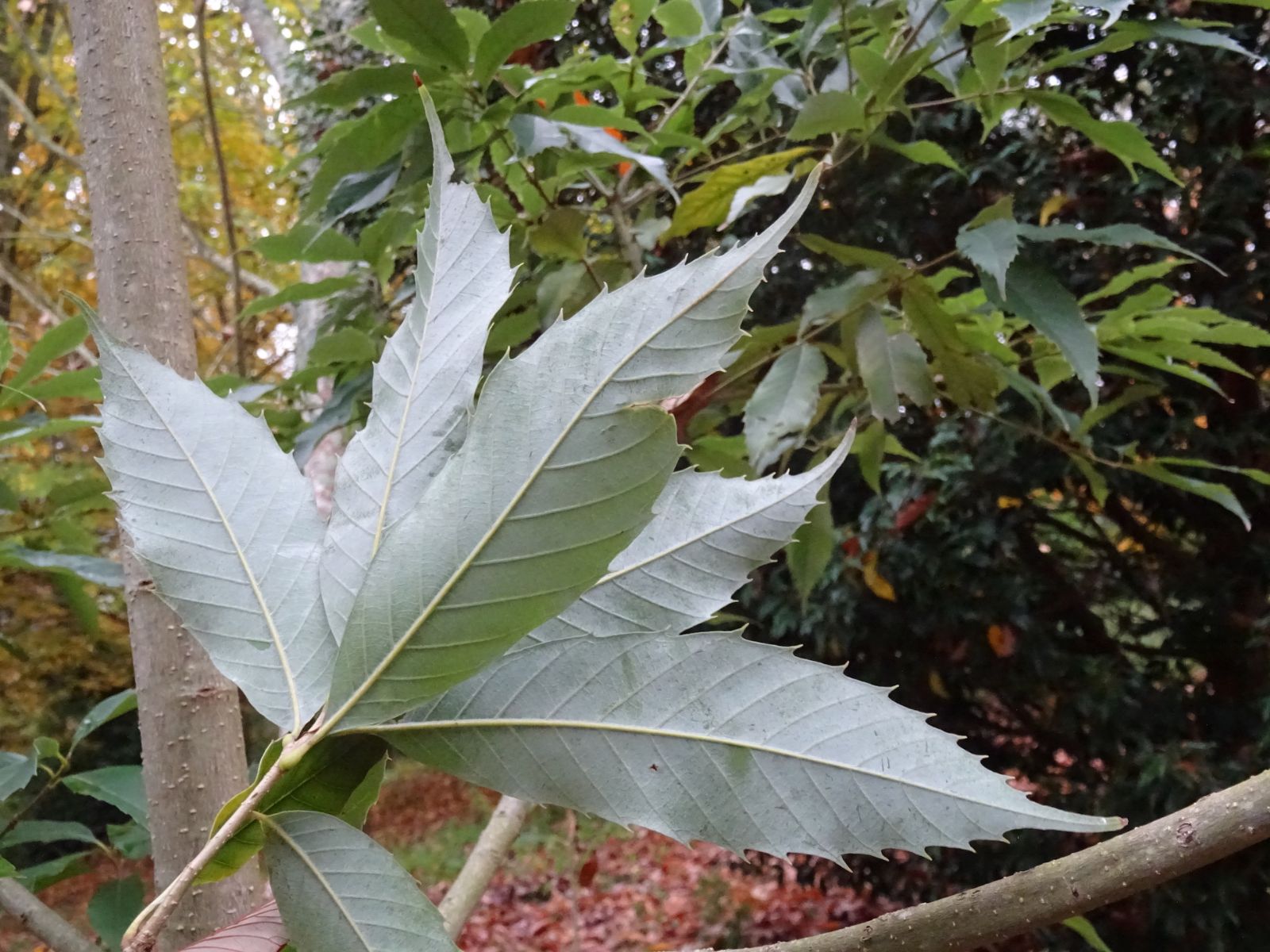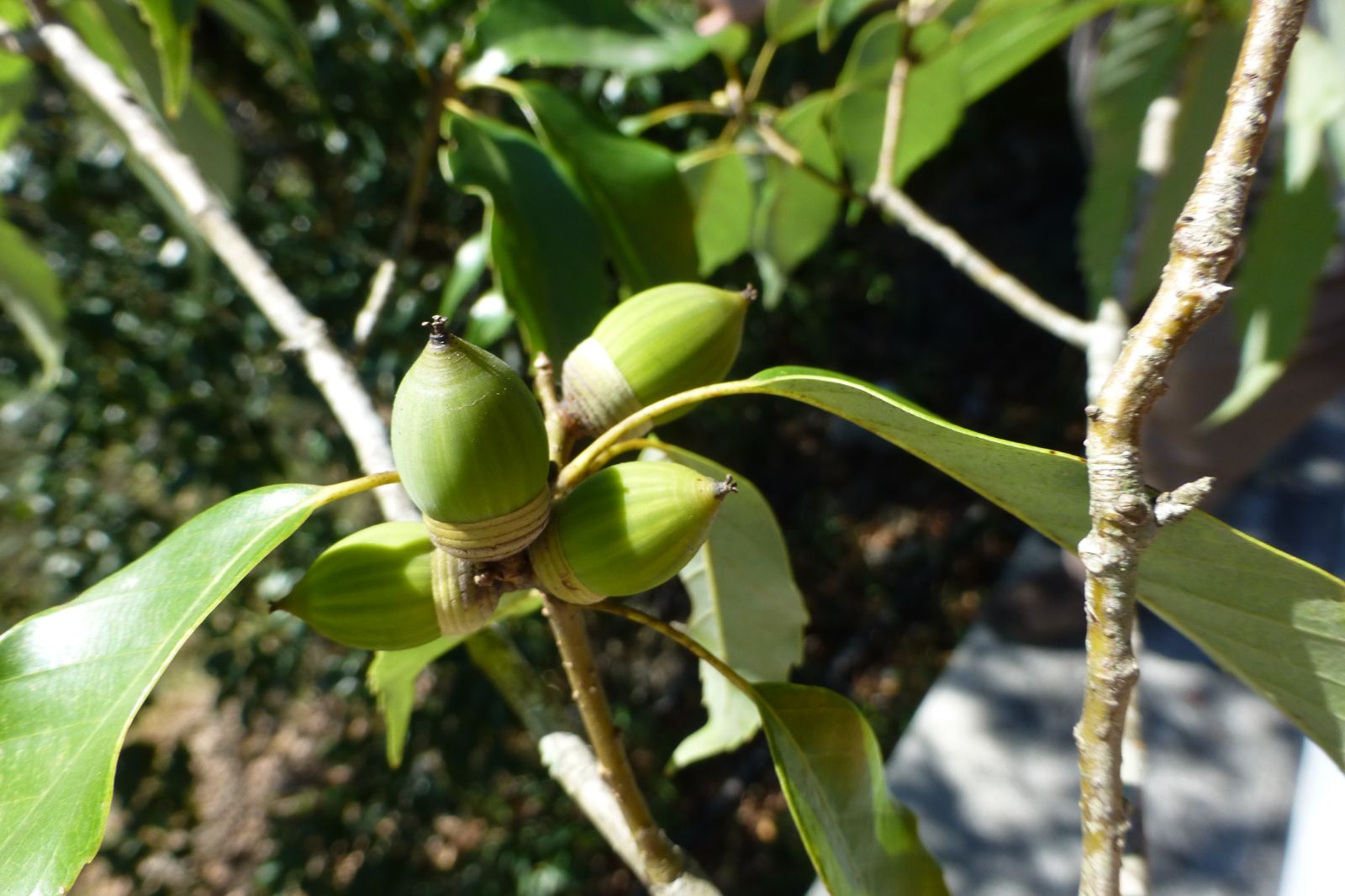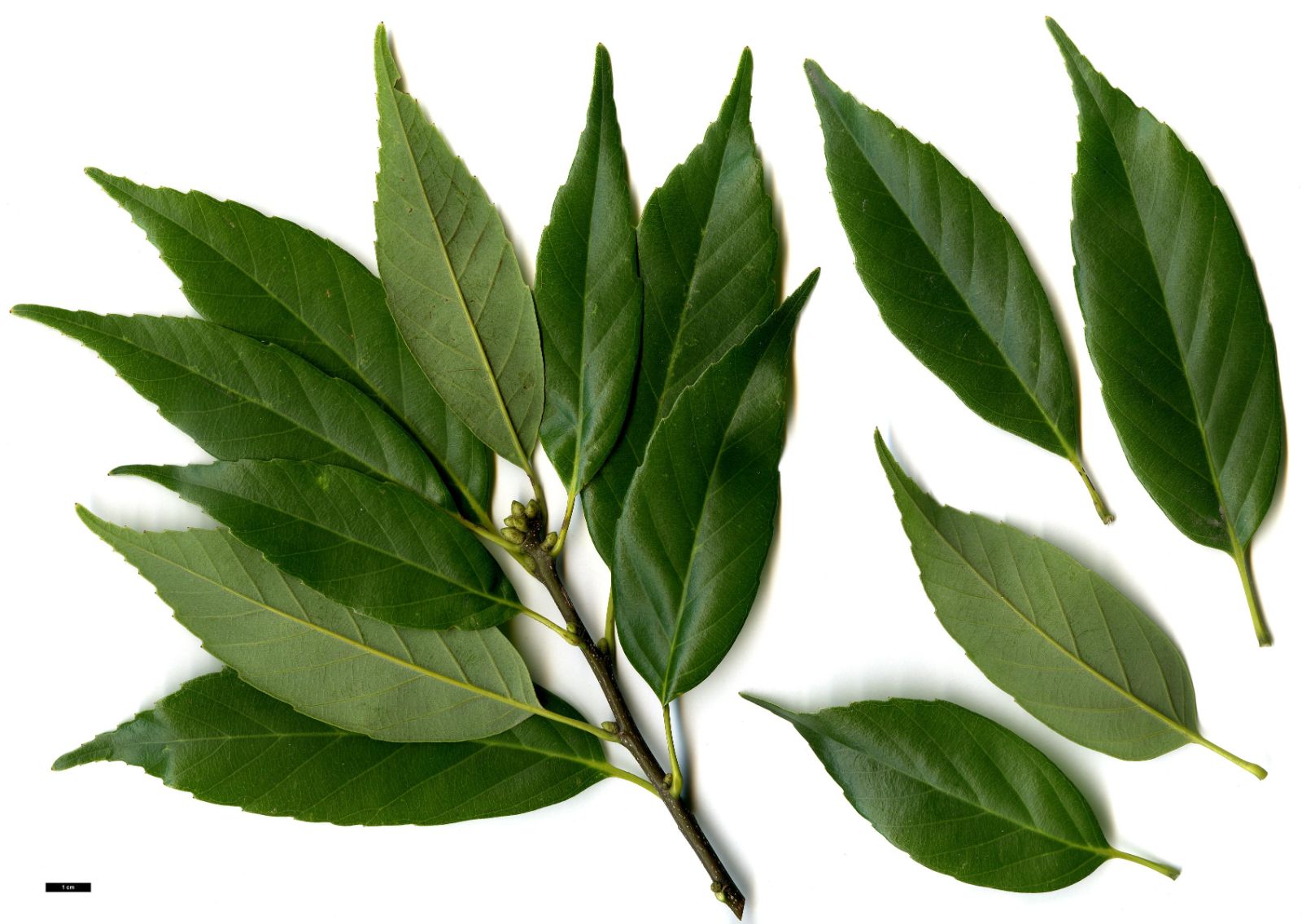Quercus glauca
Sponsor
Kindly sponsored by
The Trees and Shrubs Online Oak Consortium
Credits
Allen Coombes & Roderick Cameron (2022)
Recommended citation
Coombes, A. & Cameron, R. (2022), 'Quercus glauca' from the website Trees and Shrubs Online (treesandshrubsonline.
Genus
- Quercus
- Subgen. Cerris, Sect. Cyclobalanopsis
Common Names
- アラカシ (arakashi)
- 青冈 (qing gang)
- 종가시나무 (jonggasinamu)
- Sồi xanh
- Japanese blue oak
- Chêne bleu du Japon
Synonyms
- Cyclobalanopsis annulata (Sm.) Oerst
- Cyclobalanopsis glauca (Thunb.) Oerst.
- Perytis glauca (Thunb.) Raf.
- Quercus amamiana Hatus.
- Quercus annulata Sm.
- Quercus ciliaris C.C. Huang & Y.T. Chang
- Quercus dentosa Lindl. ex Wall.
- Quercus glauca f. gracilis Rehder & E.H. Wilson
- Quercus glauca var. amamiana (Hatus.) Hatus. ex H. Ohba
- Quercus globosa (T.P. Lin & T.S. Liu) J.C. Liao
- Quercus ichangensis Nakai ex A. Camus
- Quercus lacera Blume
- Quercus laxiflora Lindl. ex Wall.
- Quercus liboensis Z.K. Zhou
- Quercus longipes Hu
- Quercus matasii Verh.
- Quercus repandifolia J.C. Liao
- Quercus sasakii Kaneh.
- Quercus tranninhensis Hickel & A. Camus
- Quercus vaniotii H. Lév.
- Quercus vibrayeana Franch. & Sav.
Other taxa in genus
- Quercus acerifolia
- Quercus acherdophylla
- Quercus acrodonta
- Quercus acuta
- Quercus acutifolia
- Quercus acutissima
- Quercus afares
- Quercus affinis
- Quercus agrifolia
- Quercus alba
- Quercus aliena
- Quercus alnifolia
- Quercus aquifolioides
- Quercus arizonica
- Quercus arkansana
- Quercus aucheri
- Quercus augustini
- Quercus austrina
- Quercus × auzendei
- Quercus baloot
- Quercus bambusifolia
- Quercus baronii
- Quercus bicolor
- Quercus brantii
- Quercus buckleyi
- Quercus canariensis
- Quercus canbyi
- Quercus candicans
- Quercus castanea
- Quercus castaneifolia
- Quercus cerris
- Quercus chenii
- Quercus chrysolepis
- Quercus coccifera
- Quercus cocciferoides
- Quercus coccinea
- Quercus conspersa
- Quercus crassifolia
- Quercus crassipes
- Quercus delavayi
- Quercus dentata
- Quercus deserticola
- Quercus dolicholepis
- Quercus douglasii
- Quercus dumosa
- Quercus durifolia
- Quercus eduardii
- Quercus ellipsoidalis
- Quercus emoryi
- Quercus engelmannii
- Quercus engleriana
- Quercus euboica
- Quercus eugeniifolia
- Quercus fabri
- Quercus faginea
- Quercus falcata
- Quercus floribunda
- Quercus frainetto
- Quercus franchetii
- Quercus fruticosa
- Quercus fusiformis
- Quercus gambelii
- Quercus garryana
- Quercus geminata
- Quercus georgiana
- Quercus germana
- Quercus gilliana
- Quercus gilva
- Quercus glabrescens
- Quercus graciliformis
- Quercus gravesii
- Quercus griffithii
- Quercus grisea
- Quercus guyavifolia
- Quercus hartwissiana
- Quercus hemisphaerica
- Quercus × hispanica
- Quercus hondae
- Quercus hypargyrea
- Quercus hypoleucoides
- Quercus ilex
- Quercus ilicifolia
- Quercus imbricaria
- Quercus incana
- Quercus infectoria
- Quercus insignis
- Quercus ithaburensis
- Quercus kelloggii
- Quercus × kewensis
- Quercus kiukiangensis
- Quercus laceyi
- Quercus laevis
- Quercus lamellosa
- Quercus lanata
- Quercus lancifolia
- Quercus laurifolia
- Quercus laurina
- Quercus × leana
- Quercus leucotrichophora
- Quercus × libanerris
- Quercus libani
- Quercus lobata
- Quercus lobbii
- Quercus lodicosa
- Quercus longinux
- Quercus longispica
- Quercus look
- Quercus × ludoviciana
- Quercus macranthera
- Quercus macrocalyx
- Quercus macrocarpa
- Quercus macrolepis
- Quercus marilandica
- Quercus mexicana
- Quercus michauxii
- Quercus mongolica
- Quercus monimotricha
- Quercus montana
- Quercus morii
- Quercus muehlenbergii
- Quercus myrsinifolia
- Quercus myrtifolia
- Quercus nigra
- Quercus × numidica
- Quercus oblongifolia
- Quercus obtusata
- Quercus oglethorpensis
- Quercus oxyodon
- Quercus pagoda
- Quercus palmeri
- Quercus palustris
- Quercus pannosa
- Quercus parvula
- Quercus petraea
- Quercus phellos
- Quercus phillyreoides
- Quercus planipocula
- Quercus poilanei
- Quercus polymorpha
- Quercus pontica
- Quercus prinoides
- Quercus pubescens
- Quercus pyrenaica
- Quercus rehderiana
- Quercus reticulata
- Quercus robur
- Quercus rotundifolia
- Quercus rubra
- Quercus rugosa
- Quercus rysophylla
- Quercus sadleriana
- Quercus salicina
- Quercus sartorii
- Quercus × schneideri
- Quercus schottkyana
- Quercus semecarpifolia
- Quercus senescens
- Quercus serrata
- Quercus sessilifolia
- Quercus setulosa
- Quercus shumardii
- Quercus sinuata
- Quercus spinosa
- Quercus stellata
- Quercus stenophylloides
- Quercus suber
- Quercus subspathulata
- Quercus tarokoensis
- Quercus tatakaensis
- Quercus texana
- Quercus tomentella
- Quercus trojana
- Quercus tungmaiensis
- Quercus turbinella
- Quercus × turneri
- Quercus undulata
- Quercus utahensis
- Quercus utilis
- Quercus uxoris
- Quercus variabilis
- Quercus velutina
- Quercus virginiana
- Quercus vulcanica
- Quercus warburgii
- Quercus wislizenii
- Quercus xalapensis
Tree to 20 m and 80 cm trunk diameter across most of its range, largest in the Himalayas where it can reach 26 m and 1.3 m diameter. Bark smooth, greyish brown to dark brown, becoming fissured and rough with age. Young shoots purple or brownish, lightly covered in yellow pubescence on emerging then soon becoming glabrous and olive brown or yellowish brown. Twigs bear pale but visible lenticels and turn greyish brown in the second year. Buds ovoid, often quadrangular (or five sided), reddish brown, to 3 mm long, scales ciliate at the base, green or yellowish green sometimes edged with brown. Leaves elliptic, oblong, or lanceolate, 6–13 × 2–5.5 cm, sometimes broadest slightly above the middle, leathery, base usually cuneate, rarely almost rounded, slightly asymmetrical, apex acuminate, glabrous above, the underside glaucous and more or less permanently coated with appressed silky hairs, main veins in 8–16 pairs, prominent beneath, margins of leaf shallowly toothed in the upper part. Leaves emerge covered in silky pubescence, purple or brown, falling in the second autumn. Cupule cup-shaped or bowl-shaped, 6–8 mm × 0.9–1.4 cm, enclosing one third to half of the acorn, comprising 5–7 rings, outside white, slightly pubescent or glabrous, silky white inside, margin entire or finely toothed. Acorn ovoid, oblong-ovoid, or ellipsoid, glabrous or rarely hairy, sometimes striated, shiny, pale brown or reddish brown, 1–2 cm × 0.9–1.4 cm, apex conical, solitary or in groups of three at most, but often grouped closely on a fruiting stalk 1.5–2 cm long, ripening the first season. (le Hardÿ de Beaulieu & Lamant 2010; Huang, Zhang & Bartholomew 1999).
Distribution Afghanistan Bhutan China Anhui, Fujian, Gansu, Guangdong, Guangxi, Guizhou, Henan, Hubei, Hunan, Jiangsu, Jiangxi, Shaanxi, W Sichuan, E Xizang, W to SW Yunnan, Zhejiang India Jammu & Kashmir, Sikkim Japan Honshu, Shikoku, Kyushu, Ryukyu South Korea Nepal Vietnam Taiwan
Habitat Broad-leaved evergreen forests and mixed mesophytic forests on mountain slopes or in valleys, 100–2600 m asl. In northern India it grows in association with Pinus roxburghii, Pyrus pashia, Quercus leucotrichophora and Q. lanata. Elsewhere it can be found with Lithocarpus, Castanopsis, and Lindera species, among others.
USDA Hardiness Zone 7
Conservation status Least concern (LC)
Taxonomic note Quercus ciliaris is a renaming of Quercus glauca f. gracilis, which Rehder & Wilson regarded as a small-leaved form of Q. glauca with leaves up to 8 × 2.5 cm (Sargent 1917). Comparing it to Q. myrsinifolia they stated that it differed in having the leaves pubescent rather than glabrous beneath. They wrote that it was not common in western Hupeh and grows with the type species. The original Wilson specimen shows leaves similar to Q. glauca but narrower. For other plants grown as Q. ciliaris see Q. hypargyrea. Quercus annulata was described from specimens collected by Scottish physician Francis Buchanan-Hamilton in Nepal. Smith (1814) described it as: ‘Leaves evergreen, rigid, exactly like those of [Q. glauca], but somewhat silky beneath, and less glaucous, the young ones very silky.’ Quercus glauca is variable in the colour of the leaf underside and the leaves can be silky when young. Smith continues: ‘We find great reason to think that it may be, as Dr. Buchanan suspected, the same species with Thunberg’s glauca.’ Quercus glauca var. amamiana was described (as Q. amamiana) from a cultivated plant in the Botanic Garden of the Department of Agriculture, Kagoshima University, in the south of Kyushu, Japan (Hatusima 1951). It was said to differ from typical Q. glauca in its ‘somewhat narrower leaves being not glaucous and less pubescent beneath, and in its longer nuts and deeper cupules’ and is native to the Ryukyu Islands. It is named after its origin in the Amami Islands.
Quercus glauca is one of the most widely distributed oak species, spanning most of East Asia from the western Himalayas in Afghanistan to western Japan. It is the only Section Cyclobalanopsis oak found in the western Himalayas. In native habitat, it appreciates warm locations and acid soils; it is also found on clay, shale, and sandstone. It is one of the hardier ring-cupped oaks (USDA zone 7), though it can be susceptible to late frosts when young. In Japan it is frequently cultivated, especially as hedges, making an excellent screen, but one that requires maintenance. Its most attractive feature, however, is the new growth in spring, which emerges in hues ranging from chocolate to burgundy. Le Hardÿ de Beaulieu and Lamant (2010) recommend planting as a group for best ornamental effect. It resists fire, but does not take kindly to transplanting. In cultivation it forms a wide, graceful umbrella with silvery bark and is often multistemmed. According to Sean Hogan (2008), the colour of the new growth harmonizes pleasantly with the silvery bark, and the ‘lighter colors of bark and leaf together create brightness even in its own shade.’
Though described from Japan in 1784, it was introduced to Europe in 1804 as seed from Nepal; this was the earliest introduction of an Asian oak species (le Hardÿ de Beaulieu & Lamant 2010). Loudon (1844) mentions trees reaching 3 m in Kew and other locations in southern England (as Q. annulata); the Kew collector Richard Oldham sent Q. glauca seed from Japan around 1861 (Bean 1976). Elwes & Henry (1906–1913) reported in 1910 that these early introductions had not survived, but a 1907 introduction from Japan grew as a small tree at Kew (as var. lacera). They mention a specimen of Q. glauca at Tortworth, where it proved perfectly hardy but had borne no fruit. In 1915, Bean described Q. glauca as the rarest oak at Tortworth, represented by two trees of bushy habit, the larger one around 7 m tall and across, ‘undoubtedly the finest in England.’ Both Elwes & Henry and Bean mention other trees under Q. vibrayeana, apparently more common in cultivation. E.H. Wilson collected Q. glauca in the early 1900s in China, where he found it to be the commonest evergreen oak in western Hubei and eastern Sichuan, growing from river-level to 1600 m. He described it as a ‘handsome tree with a bushy, flattened-round head of widespreading branches’ (Sargent 1917). The earlier introductions at Kew have not survived: the oldest surviving tree currently in Kew records is at Wakehurst, accessioned in 1969 (H. Baldwin pers. comm.; The Tree Register 2021).
Though Bean observed that Q. glauca was very rare in UK gardens and warned that it was ‘only suitable for the mildest parts of the country,’ specimens grow today in some colder areas, such as Mount Usher in Ireland (9 m × 24 cm dbh in 2015) and Dundee University Botanic Garden in Scotland (10 m × 22 cm dbh in 2017) (The Tree Register 2021). At Howick Arboretum, a multistemmed tree, reaching 7 m with a 5 m canopy spread, was grown from seed collected by Warner & Howick (WH 784) in Honshu, Japan in 1987 (Howick Hall Arboretum 2021; R. Jamieson pers. comm.). Several trees are recorded in gardens in warmer climates, and the current UK Champion is at Caerhays Castle (12 m × 46 cm in 2016), though it was ‘rather sparse’ in 2016 (The Tree Register 2021) and Charles Williams noted in May, 2021 that it was ‘partially dead … but still has some vigorous growth’ (Williams 2021). A tree at Sir Harold Hillier Gardens equalled the 12 m mark in 2020, with a dbh of 40 cm measured below a fork at 1 m (The Tree Register 2021).
At Bambouseraie en Cévennes, Languedoc-Roussillon, France, three trees survive, planted in the 1860s. Of these, the best tree measured 20.5 m × 0.85 m dbh in 2003, with a 15 m wide canopy. At l’Arboretum National des Barres, Loiret, France, a tree planted in 1936 started producing acorns at age 60 (le Hardÿ de Beaulieu & Lamant 2010). At Arboretum de la Bergerette in southwestern France, specimens have survived dry summers but have not increased in size without extra water (Haddock 2012).
In the U.S. it grows in gardens in the milder regions in the Southeast and on the West Coast. Plants originating from northern locations in China and Japan have been most successful in cultivation (Hogan 2008). At Washington Park Arboretum in Seattle trees accessioned in 1937, of nursery origin, proved ‘as hardy as any of [their] evergreen oaks’, surviving frost damage during a severe winter in 1955. Cuttings were successfully propagated under mist and the Arboretum’s bulletin recommended the species as ‘interesting and ornamental little trees [that] may find a place in Pacific northwest gardens’ (Witt 1964). At the University of Georgia Botanical Garden a tree was killed to the ground in severe cold (–19 to –23°C) but resprouted and thirty years later was an 11-stemmed tree, about 9 m tall and wide (Dirr & Warren 2019). Mark Weathington (2014) reported that Q. glauca performs very well in the summer moisture and heat at JC Raulston Arboretum in Raleigh, North Carolina; it has proved reliably hardy to zone 8 and many plants grow happily in zone 7 gardens, where their winter prospects are no doubt much improved by long, hot summers. Though a plant at the arboretum was killed to the ground in a the severe winter of 1985, it subsequently re-sprouted as a multistemmed tree reaching 12 m in 2014. Softwood cuttings root easily and dormant cuttings under mist with bottom heat root in as little as 3–4 weeks. Specimens also grow at Huntington Botanical Gardens (Quarryhill Botanical Garden 2001), the U.S. National Arboretum (received as Q. myrsinifolia) (US National Arboretum 2019), and at Armstrong State Universty, where trees have been in the grounds for over 15 years and grown steadily, the largest reaching about 18 m with a large, round crown (P. Schretter pers. comm.). At Starhill Forest Arboretum Q. glauca is grown but is kept in a cool greenhouse during winter (G. Sternberg, pers. comm.).
It is also found in several arboreta in the Southern Hemisphere. Plants received from Hillier Nurseries grow at Eastwoodhil Arboretum and Hackfalls Arboretum in New Zealand; at Hackfalls, several more specimens grown from seed of varied origin have grown well, some received as Q. myrsinifolia and Q. hondae (Eastwoodhill Arboretum pers. comm.; Hackfalls Arboretum 2021). In Australia it grows well in Geoff Bogles’ arboretum at Hoddles Creek, Victoria (D. Teese pers. comm.), while in Argentina several specimens grown from seed sourced from the 150-year-old specimens at Bambouseriae Prafrance (see above), planted in 1997, have grown well and unscathed by the frosts at San Miguel Arboretum (P. Laharrague pers. comm.).
It is also at Kunming Botanical Garden (S. Weibang pers. comm. 2021).
While this is a variable and widely distributed species, one variant that stands out as distinct was grown from seed collected by Ian Sinclair and David Long at 1640 m in Bhutan in 1984 (Sinclair & Long 5630). This collection is grown at Benmore Botanic Garden and at the Sir Harold Hillier Gardens (Royal Botanic Garden Edinburgh 2021). The latter plant has the leaves sharply toothed except towards the base and ending in a slender, tail-like, mostly entire point. They are white with hairs on both sides when young, becoming glossy dark green above, glaucous-white beneath. It was 6.6 m × 17.6 cm at 0.7 m with a spread of 7.7 m in 2021 (B. Clarke pers. comm.).
Plants grown from seed received from China as Q. ningangensis (after Ninggang, Jianxi, China) appear to be Q. glauca (it is grown under this name at Iturraran Botanical Garden).
Some plants are in cultivation under names regarded here as synonyms. A plant grown from seed received at Sir Harold Hillier Gardens as Q. liboensis is very close to Q. glauca but also has narrow leaves that could be interpreted as f. gracilis (Royal Botanic Garden Edinburgh 1997). Plants grown from seed received from China as Q. liboensis are also at Penrice Castle (T. Methuen-Campbell pers. comm. 2021). It is named after Libo County, Guizhou, China.
At Iturraran a plant grown as Q. annulata derives from seed collected in Myanmar by Jean Merret in 2009 (F. Garin pers. comm.). There are three plants from this collection at Penrice Castle, Wales, the largest 3 m tall in 2021 (T. Methuen-Campbell pers. comm.). The epithet derives from the Latin for ‘ringed’, as Smith described the acorn cup as having ‘concentric, annular, imbricated, crenate scales.’ Q. glauca var. amamiana was introduced by Shaun Haddock and Anke Mattern from the humid, subtropical island of Amami Ōshima, Japan in 2007, but seems to have been particularly tender. A plant introduced by Allen Coombes from 1300 m in Yunnan in 1998 as Q. pentacycla is not that species but is close to Q. glauca and Q. schottkyana. Judging by a plant at Chevithorne Barton, England, where it was cut to the ground by frost, it is much more tender than both of those species and has very conspicuous red young foliage. It may represent Q. stewardiana, regarded as a synonym of Q. glauca by Menitsky.
In cultivation and the nursery trade this species is often confused with Q. myrsinifolia, from which it can be distinguished by the appressed silky hairs on the underside of the leaf; these are absent in Q. myrsinifolia.
It is known in Japanese as arakashi, where ara means ‘rough, rough-edged’ and kashi is the name for evergreen oaks. The roughness may be in reference to the hard wood, the edge of the serrated leaf margins, or the appearance of the branches (Matsumura 2021). The common name may have evolved from the contrast between this species and Q. myrsinifolia, both of which grow together in Western Japan: these ‘rough’ characteristics were interpreted as ‘masculine’ in juxtaposition to the more ‘femenine’ character of Q. myrsifinolia’s lighter foliage, slenderer leaves, and more graceful branching (K. Tokunaga pers. comm.). This is borne out by another common name for Q. glauca in japanese, kurokashi (‘black oak’), which contrasts with shirakashi (‘white oak), the name for Q. myrsinifolia. The common name in Chinese, qing gang, can be translated as ‘evergreen oak’ (all common names in Chinese for section Cyclobalanopsis oaks are based on qing gang). In Vietnamese, the vernaulcar name means ‘green oak’. In English and French the common names for Q. glauca are based, somewhat abritrarily, on the colour blue, in reference to the glaucous undersides of the leaves, the feature also selected by Thunberg when he described the species in 1784. The term glauca is of uncertain origin, but derives from the Greek γλαύκος (glaukos), used in Homer to describe the sea as ‘gleaming, silvery’, but by later writers to describe the ‘greenish’ colour of olive leaves and a blue or grey eye colour (Harper 2021). In botany it can mean bluish-grey or refer to a surface covered with a fine, waxy bloom, like the skin of a plum (Eckel 2021). The hard, dense wood (about 1 ton per cubic metre) is highly prized in construction, for making tool handles, and for charcoal; in pre-industrial times, forests of Q. glauca in Japan were managed as a source of fuel. The acorns were used for human consumption and animal fodder, and the branches were also fed to livestock. The leaves are used in the cultivation of silk worms (INRAE 2021; le Hardÿ de Beaulieu & Lamant 2010).



